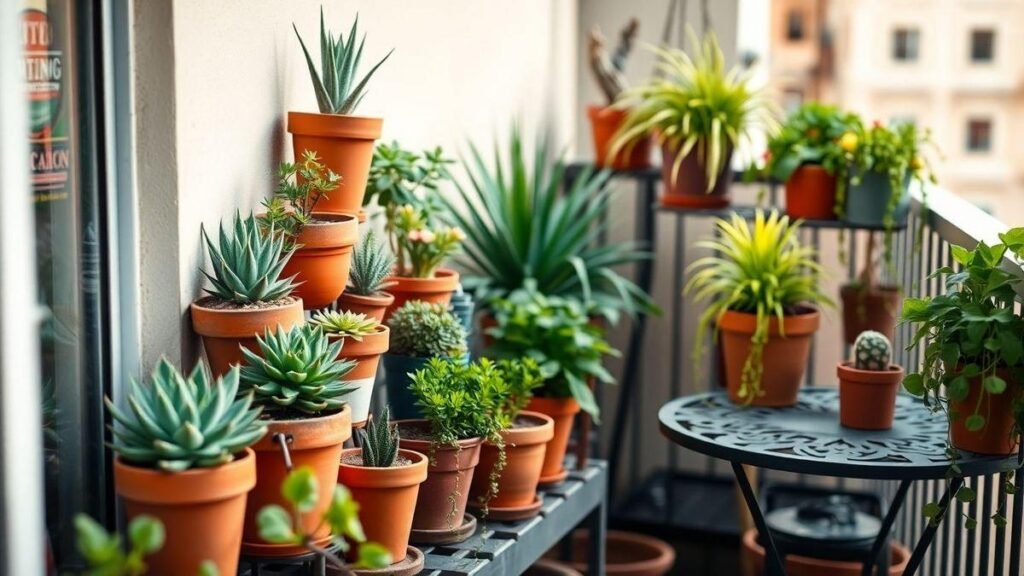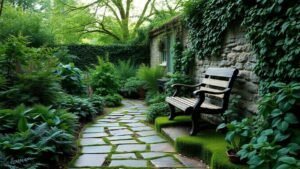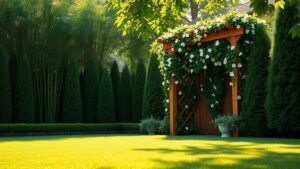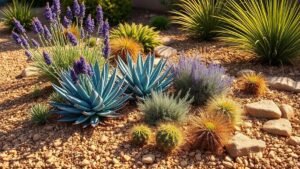Container Plants for small patios with limited sunlight
Container Plants for small patios with limited sunlight are my secret superpower. I choose shade‑tolerant favorites (ferns, hostas) plus a few low‑maintenance rebels (succulents, sedums). I always check water and soil needs, use self‑watering pots, mulch, or smart pots to cut chores, and favor compact bloomers and trailing plants to save space. Small habits—deadheading, rotating, pruning, and a quick light check with a phone app—keep a tiny patio looking like a mini green kingdom.
Key takeaway
- Pick shade‑tolerant and low‑maintenance plants suited to your hours of light.
- Use well‑draining potting mix and pots with drainage holes.
- Save floor space with tall/narrow pots, hanging baskets, and trailing plants.
- Cut chores with self‑watering pots, mulch, and smart pots.
- Rotate and prune regularly so every side gets light.
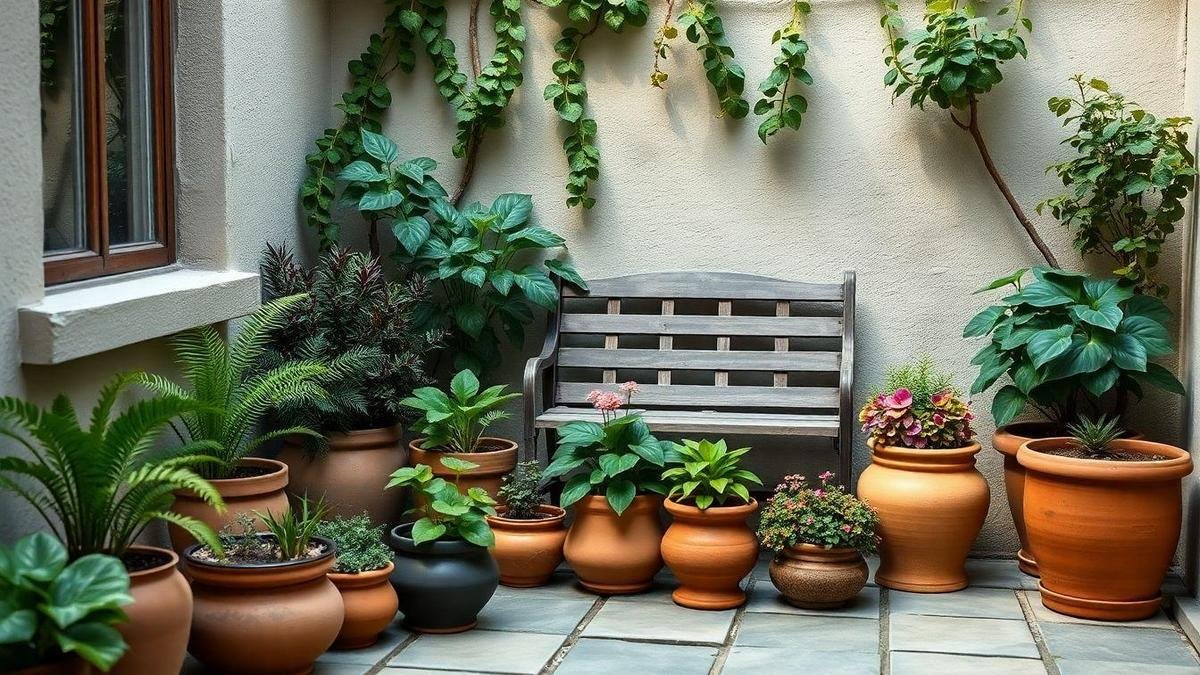
Choosing the best container plants for small patios that thrive in low light
I look for plants that stay happy in low light and small pots—slow, steady growers that forgive forgetfulness. For anyone searching “Container Plants for small patios with limited sunlight,” focus on these dependable options and remember to check guides to best plants for low‑light gardens when planning placements:
| Plant | Light | Pot size | Water |
|---|---|---|---|
| Snake plant | Low–medium | 6–10 in | Drought‑tolerant |
| Peace lily | Low | 8–12 in | Keep soil moist |
| Boston fern | Low, humid | 8–12 in | Likes misting |
| Hosta | Deep shade | 8–12 in | Even moisture |
| Pothos | Low | Hanging pot | Let top dry between waterings |
| Cast iron plant | Very low | 6–10 in | Rare watering |
Quick rules: choose pots with drainage, use container potting mix, and add a pebble tray for ferns or a saucer for spillers (see tips on preventing over‑ and underwatering).
Shade favorites: ferns and hostas
I love ferns (soft texture) and hostas (bold foliage). Both fit small pots and tolerate more shade than many bloomers. Choose compact varieties, pot hostas in wide, shallow containers for root comfort, and pinch back long fronds as needed. If a plant shows droopy leaves after a week, it’s telling you it needs adjustment—bigger pot, more moisture, or a brighter spot. For more shade‑friendly options, check resources on low‑light garden plants.
Low‑maintenance picks: succulents and sedums
For busy weeks I lean on Container Plants for small patios with limited sunlight that tolerate skips in care—Haworthia, Gasteria, and shade‑tolerant sedums. Shade‑tolerant succulents are covered well in the guide to succulent plants for drought‑tolerant landscaping.
| Plant | Light | Watering | Why I like it |
|---|---|---|---|
| Haworthia | Low–bright indirect | Every 2–3 weeks | Tough, small |
| Gasteria | Low–bright indirect | Every 2–3 weeks | Shade tolerant |
| Sedum spurium | Part sun–partial shade | Every 1–2 weeks | Spreads, colorful leaves |
Test soil with your finger: dry = skip watering; damp = wait. For more low‑maintenance ideas, see best plants for a low‑maintenance garden.
Pots, soil and watering — make life easy
- Use well‑draining pots and potting mix for containers.
- Match plants to pot type: fabric/smart pots for airflow, self‑watering pots for travel.
- Top with a thin layer of mulch to reduce evaporation (keep thin to avoid rot).
- Tip: fill self‑watering reservoirs before trips and use water‑saving techniques.
Benefits: fewer wilted leaves, less frequent watering, and steadier root health. If you compost at home, incorporate homemade compost (see how to start a compost bin) into potting mixes sparingly for extra nutrient boost.
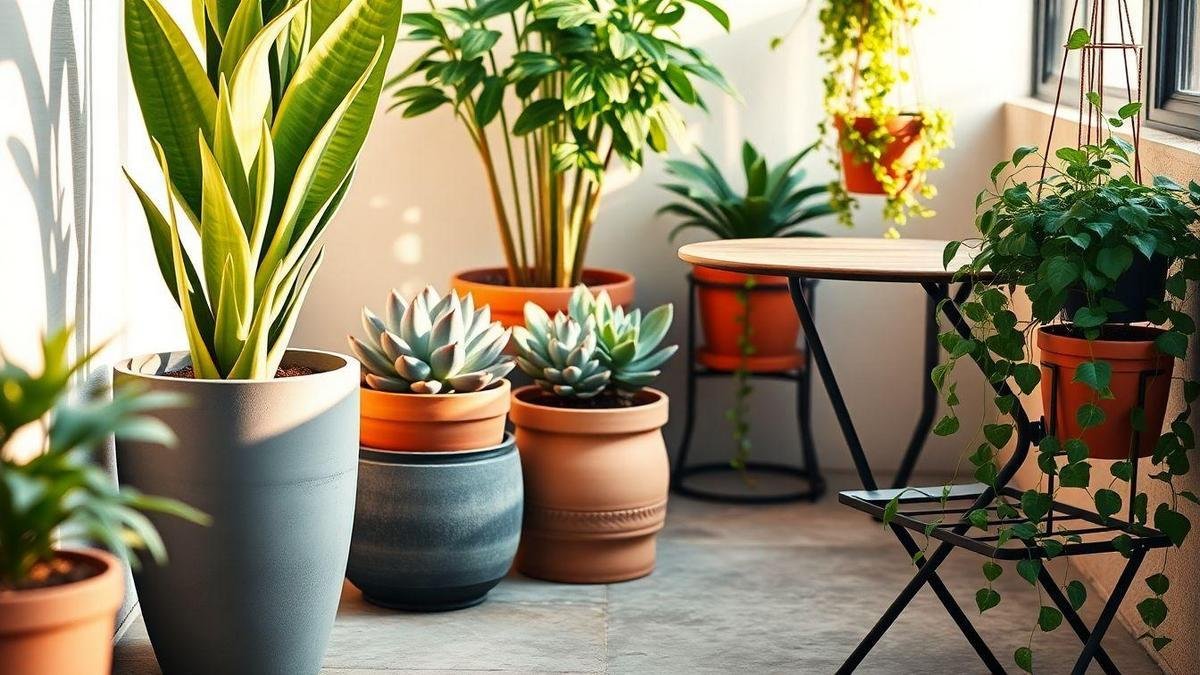
Compact flowering plants for color without crowding
I prefer pots that wink, not shout. Compact bloomers add color without overwhelming limited space.
| Plant | Bloom season | Light needs | Pot size | Notes |
|---|---|---|---|---|
| Dwarf geraniums | Spring–fall | Full sun–part shade | 6–10 in | Sturdy, bright |
| Calibrachoa | Spring–frost | Full sun–part sun | 6–12 in | Great for spillover |
| Bacopa | Late spring–frost | Part sun–part shade | 6–10 in | Good in hanging pots |
| Lobelia | Summer | Part shade | 6–8 in | Cool weather favorite |
| Alyssum | Spring–fall | Full–part sun | 4–8 in | Small flowers, sweet scent |
Match tag instructions (light and bloom season) to your patio hours. My rule: one fast bloomer, one filler, one reliable stayer. For more ideas on arranging small spaces, see small garden ideas to maximize your space.
Herbs: tiny victories and natural pest control
Herbs give flavor and companion benefits with little fuss—ideal for Container Plants for small patios with limited sunlight.
| Herb | Pot depth | Light | Harvest tip |
|---|---|---|---|
| Basil | 6–8 in | Partial sun | Pinch top leaves often |
| Parsley | 6 in | Partial shade OK | Cut outer stems first |
| Chives | 4–6 in | Low light OK | Snip leaves near base |
Benefits: basil masks pests for nearby plants, chives deter aphids, parsley attracts beneficial insects (see plants that attract pollinators). Water in the morning; most herbs need watering every 3–5 days in warm weather. Trim weekly and hard‑cut once a month. If you want to grow edibles in less sun, check how to grow vegetables in shade.
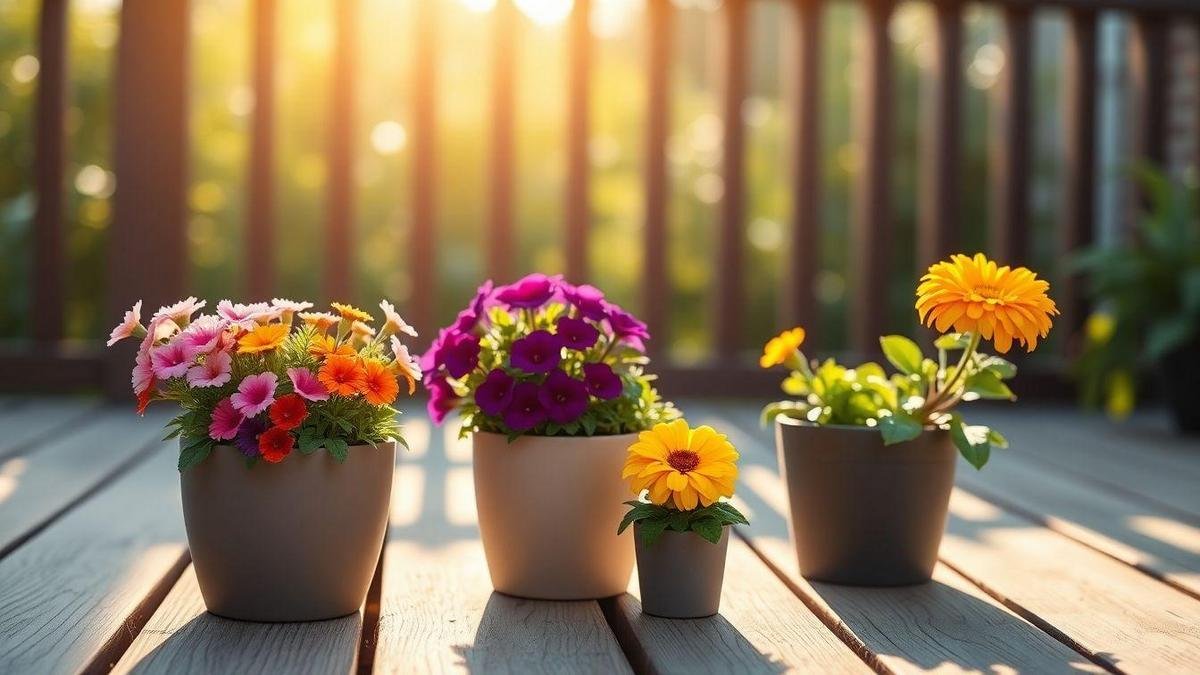
Trailing plants and vertical solutions to save space
Trailing plants make a small patio feel larger. Hang baskets, stack pots, and use tall narrow containers—see space‑saving setups for inspiration.
| Plant | Light | Water | Drama | Note |
|---|---|---|---|---|
| Ivy | Low–part shade | Moderate | High | Best in shady spots |
| Creeping thyme | Part sun | Low–moderate | Low | Likes brighter spots for flowers |
| Sweet potato vine | Part shade–sun | Moderate | Very high | Color varies with light |
Hanging tips: hang at eye level for impact; use coco liners; keep baskets out of pet reach. Rotate pots weekly and prune runners every 4–6 weeks for balanced growth.
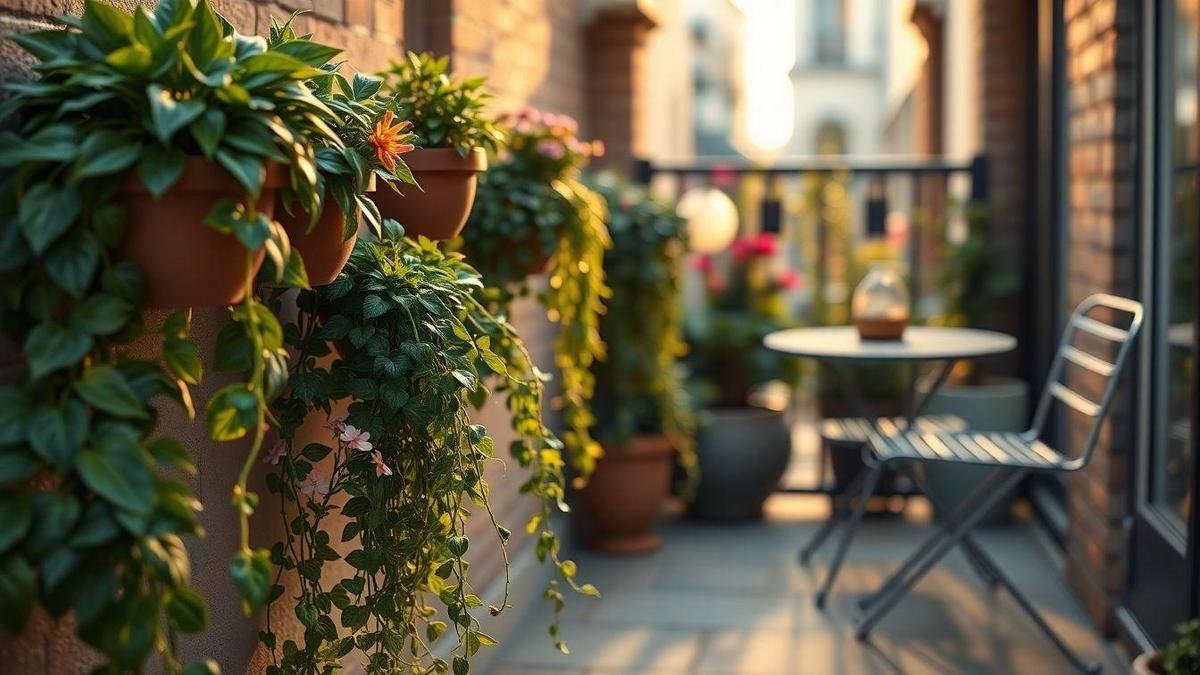
Placement, light measurement and seasonal swaps
- Use a light‑meter app to log direct and bright light hours.
- If a spot has under two hours of direct sun, prioritize shade‑friendly plants there and consult low‑light plant recommendations.
- Keep a list of high‑light candidates and swap them into the sunniest patch when needed.
- Mix foliage, evergreen, and flowers for year‑round interest—contrast leaf shapes, vary heights, and repeat one or two colors.
Small seasonal moves reduce plant stress and boost blooms.
Simple maintenance routine
- Check soil: every morning or before watering.
- Water: morning; use finger test (top inch dry = water) and follow guidance on preventing over‑ and underwatering.
- Deadhead: every few days in peak season.
- Trim: light weekly snips, major cutback monthly.
- Rotate: weekly for even light exposure.
These five‑minute chores keep pots magazine‑ready and plants productive.
Conclusion
By choosing the right Container Plants for small patios with limited sunlight, matching pots and soil, and keeping a few steady habits—self‑watering pots, mulch, smart pots, pruning, deadheading, and rotating—you can turn a shady patio into a thriving, low‑stress garden. Match the plant to the spot, give roots good drainage, and keep care simple. The result: happy plants, less guilt, and a patio that wants to be seen.
For more small‑patio ideas and space‑saving tips, explore small garden ideas to maximize your space.
Frequently asked questions
Which container plants thrive on small patios with little space?
Herbs (basil, chives, thyme), compact foliage (hostas, ferns), and small succulents fit tiny pots and add lots of impact. See also best herbs for containers.
What grows well in shade on a small patio?
Ferns, hostas, heuchera, pothos, and impatiens—perfect for low‑light gardens.
How do I water pots on a tiny patio without overdoing it?
Use the finger test (top inch dry = water), prefer self‑watering pots and watering strategies, and mulch to reduce evaporation.
What pot sizes work on compact patios?
6–10 inch pots work for single plants; use wider shallow pots for hostas and herbs. Use wheels or movable trays for heavier pots.
Any quick tips to keep container plants happy on a shady patio?
Rotate monthly, use mild fertilizer, trim dead leaves quickly, and choose plants that genuinely like shade. For compact design ideas that fit tiny spaces, see space‑saving planting schemes.

